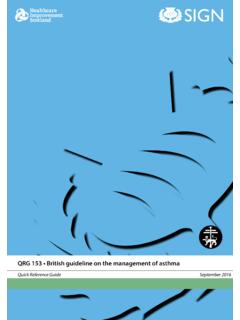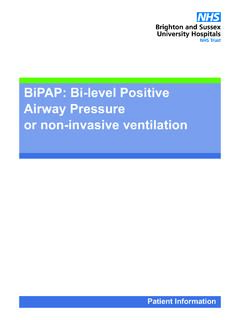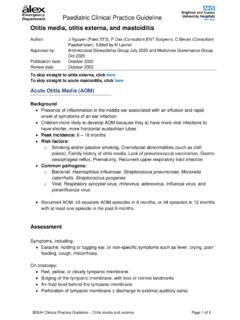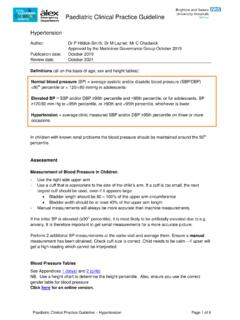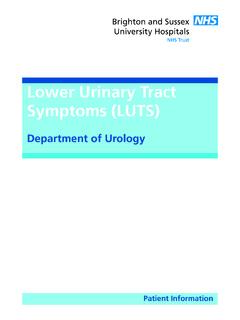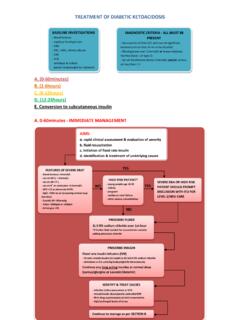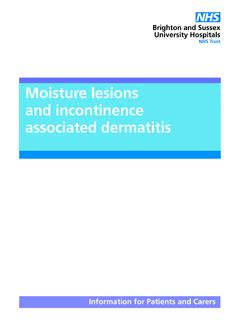Transcription of Management of spontaneous pneumothorax: British …
1 Management of spontaneous pneumothorax : BritishThoracic society pleural disease guideline 2010 Andrew MacDuff,1 Anthony Arnold,2 John Harvey,3on behalf of the BTS PleuralDisease Guideline GroupINTRODUCTIONThe term pneumothorax wasfirst coined by Itardand then Laennec in 1803 and 1819 respectively,1and refers to air in the pleural cavity (ie, inter-spersed between the lung and the chest wall). Atthat time, most cases of pneumothorax weresecondary to tuberculosis, although some wererecognised as occurring in otherwise healthypatients ( pneumothorax simple ). This classifica-tion has endured subsequently, with thefirstmodern description of pneumothorax occurring inhealthy people (primary spontaneous pneumo-thorax, PSP) being that of Kj rgaard2in 1932. It isa significant global health problem, with a reportedincidence of 18e28/100 000 cases per annum formen and 000 for pneumothorax (SSP) is associatedwith underlying lung disease, in distinction to PSP,although tuberculosis is no longer the commonestunderlying lung disease in the developed world.
2 Theconsequences of a pneumothorax in patients withpre-existing lung disease are significantly greater,and the Management is potentially more hospital admission rates for PSP and SSPin the UK have been reported as 000 formen and 000 for women, with corre-sponding mortality rates of and per annum between 1991 and regard to the aetiology of pneumothorax ,anatomical abnormalities have been demonstrated,even in the absence of overt underlying lungdisease. Subpleural blebs and bullae are found at thelung apices at thoracoscopy and on CT scanning inup to 90% of cases of PSP,56and are thought toplay a role. More recent autofluorescence studies7have revealed pleural porosities in adjacent areasthat were invisible with white light. Small airwaysobstruction, mediated by an influx of inflammatorycells, often characterises pneumothorax and maybecome manifest in the smaller airways at an earlierstage with emphysema-like changes (ELCs).
3 8 Smoking has been implicated in this aetiologicalpathway, the smoking habit being associated witha 12% risk of developing pneumothorax in healthysmoking men compared with in with PSP tend to be taller thancontrol 11 The gradient of negativepleural pressure increases from the lung base to theapex, so that alveoli at the lung apex in tall indi-viduals are subject to significantly greaterdistending pressure than those at the base of thelung, and the vectors in theory predispose to thedevelopment of apical subpleural it is to some extent counterintuitive,there is no evidence that a relationship existsbetween the onset of pneumothorax and physicalactivity, the onset being as likely to occur duringsedentary the apparent relationship betweensmoking and pneumothorax , 80e86% of youngpatients continue to smoke after theirfirst episode risk of recurrence of PSP is as high as 54%within thefirst 4 years, with isolated risk factorsincluding smoking, height and age>60 15 Risk factors for recurrence of SSP include age,pulmonaryfibrosis and 16 Thus,efforts should be directed at smoking cessation afterthe development of a initial British thoracic society (BTS)
4 guidelines for the treatment of pneumothoraceswere published in studies suggestedthat compliance with these guidelines wasimproving but remained suboptimal at only20e40% among non-respiratory and A&E guidelines have been shown to improveclinical practice,18 19compliance being related tothe complexity of practical procedures20andstrengthened by the presence of an second version of the BTS guidelineswas published in 200322andreinforcedthetrendtowards safer and less invasive managementstrategies, together with detailed advice on a rangeof associated issues and conditions. It includedalgorithms for the Management of PSP and SSPbut excluded the Management of trauma. Thisguideline seeks to consolidate and update thepneumothorax guidelines in the light of subse-quent research and using the SIGN pneumothorax is not covered by thisguideline.<SSP is associated with a higher morbidityand mortality than PSP.
5 (D)<Strong emphasis should be placed onsmoking cessation to minimise the risk ofrecurrence. (D)< pneumothorax is not usually associatedwith physical exertion. (D)CLINICAL EVALUATION<Symptoms in PSP may be minimal orabsent. In contrast, symptoms are greaterin SSP, even if the pneumothorax is rela-tively small in size. (D)<The presence of breathlessness influencesthe Management strategy. (D)<Severe symptoms and signs of respiratorydistress suggest the presence of tensionpneumothorax. (D)The typical symptoms of chest pain and dyspnoeamay be relatively minor or even absent,23so that1 Respiratory Medicine, RoyalInfirmary of Edinburgh, UK2 Department of RespiratoryMedicine, Castle Hill Hospital,Cottingham, East Yorkshire, UK3 North Bristol Lung Centre,Southmead Hospital, Bristol, UKCorrespondence toDr John Harvey, North BristolLung Centre, SouthmeadHospital, Bristol BS10 5NB, 12 February 2010 Accepted 4 March 2010ii18 Thorax2010;65(Suppl 2):ii18eii31.
6 Guidelinesa high index of initial diagnostic suspicion is required. Manypatients (especially those with PSP) therefore present severaldays after the onset of longer this period oftime, the greater is the risk of re-expansion pulmonary oedema(RPO).25 26In general, the clinical symptoms associated withSSP are more severe than those associated with PSP, and mostpatients with SSP experience breathlessness that is out ofproportion to the size of the 28 These clinicalmanifestations are therefore unreliable indicators of the size ofthe 30 When severe symptoms are accompa-nied by signs of cardiorespiratory distress, tension pneumo-thorax must be physical signs of a pneumothorax can be subtle but, char-acteristically, include reduced lung expansion, hyper-resonanceand diminished breath sounds on the side of the sounds such as clicking can occasionally be audible at thecardiac presence of observable breathlessness hasinfluenced subsequent Management in previous 23In association with these signs, cyanosis, sweating, severetachypnoea.
7 Tachycardia and hypotension may indicate thepresence of tension pneumothorax (see later section).Arterial blood gas measurements are frequently abnormal inpatients with pneumothorax , with the arterial oxygen tension(PaO2) being< kPa in 75% of patients,31but are not requiredif the oxygen saturations are adequate (>92%) on breathingroom air. The hypoxaemia is greater in cases of SSP,31the PaO2being< kPa, together with a degree of carbon dioxide reten-tion in 16% of cases in a large function testsare poor predictors of the presence or size of a pneumothorax7and, in any case, tests of forced expiration are generally bestavoided in this diagnosis of pneumothorax is usually confirmed byimaging techniques (see below) which may also yield informa-tion about the size of the pneumothorax , but clinical evaluationshould probably be the main determinant of the managementstrategy as well as assisting the initial diagnosis<Standard erect chest x-rays in inspiration are recom-mended for the initial diagnosis of pneumothorax ,rather than expiratoryfilms.
8 (A)<The widespread adoption of digital imaging (PACS)requires diagnostic caution and further studies since thepresence of a small pneumothorax may not be imme-diately apparent. (D)<CT scanning is recommended for uncertain or complexcases. (D)The following numerous imaging modalities have beenemployed for the diagnosis and Management of pneumothorax :1. Standard erect PA chest Lateral Supine and lateral decubitus Ultrasound Digital CT erect PA chest x-rayThis has been the mainstay of clinical Management of primaryand secondary pneumothorax for many years, although it isacknowledged to have limitations such as the difficulty inaccurately quantifying pneumothorax size. Major technologicaladvances in the last decade have resulted in the advent of digitalchest imaging, so that conventional chestfilms are no longereasily available in clinical practice in the UK or in many othermodern healthcare systems.
9 The diagnostic characteristic isdisplacement of the pleural line. In up to 50% of cases an air-fluid level is visible in the costophrenic angle, and this is occa-sionally the only apparent presence ofbullous lung disease can lead to the erroneous diagnosis ofpneumothorax, with unfortunate consequences for the uncertainty exists, then CT scanning is highly desirable (seebelow).Lateral x-raysThese may provide additional information when a suspectedpneumothorax is not confirmed by a PA chestfilm33but, again,are no longer routinely used in everyday clinical filmsThese are not thought to confer additional benefit in the routineassessment of and lateral decubitus x-raysThese imaging techniques have mostly been employed fortrauma patients who cannot be safely moved. They are generallyless sensitive than erect PA x-rays for the diagnosis of pneu-mothorax3738and have been superseded by ultrasound or CTimaging for patients who cannot assume the erect scanningSpecific features on ultrasound scanning are diagnostic ofpneumothorax39but, to date, the main value of this techniquehas been in the Management of supine trauma imagingDigital radiography (Picture-Archiving Communication Systems,PACS) has replaced conventionalfilm-based chest radiographyacross most UK hospitals within the last 5 years, conferringconsiderable advantages such as magnification, measurement andcontrast manipulation, ease of transmission, storage and repro-duction.
10 Relatively few studies have addressed the specific issueof pneumothorax and its diagnosis, and these have tended tofocus on expert diagnosis (by consultant radiologists) and themore discriminating departmental (rather than ward-based)workstations. Even so, some difficulties were found in the diag-nosis of pneumothorax in early then there havebeen technological advances, such that digital imaging may nowbe as reliable as more conventional chest x-rays in pneumothoraxdiagnosis, but there have been no more recent studies to confirmthis. Differences exist between the characteristics (screen size,pixel count, contrast and luminescence) and therefore the sensi-tivity of the more expensive departmental devices and thedesktop and mobile consoles available in the ward is currently recommended that, where primary diagnosticdecisions are made based on the chest x-ray, a diagnostic PACS workstation is available for image addition, digital images do not directly lend themselves tomeasurement and size calculations; an auxiliary function anduse of a cursor is required, but this is almost certainly moreaccurate than using a ruler and is easy to learn to do.
